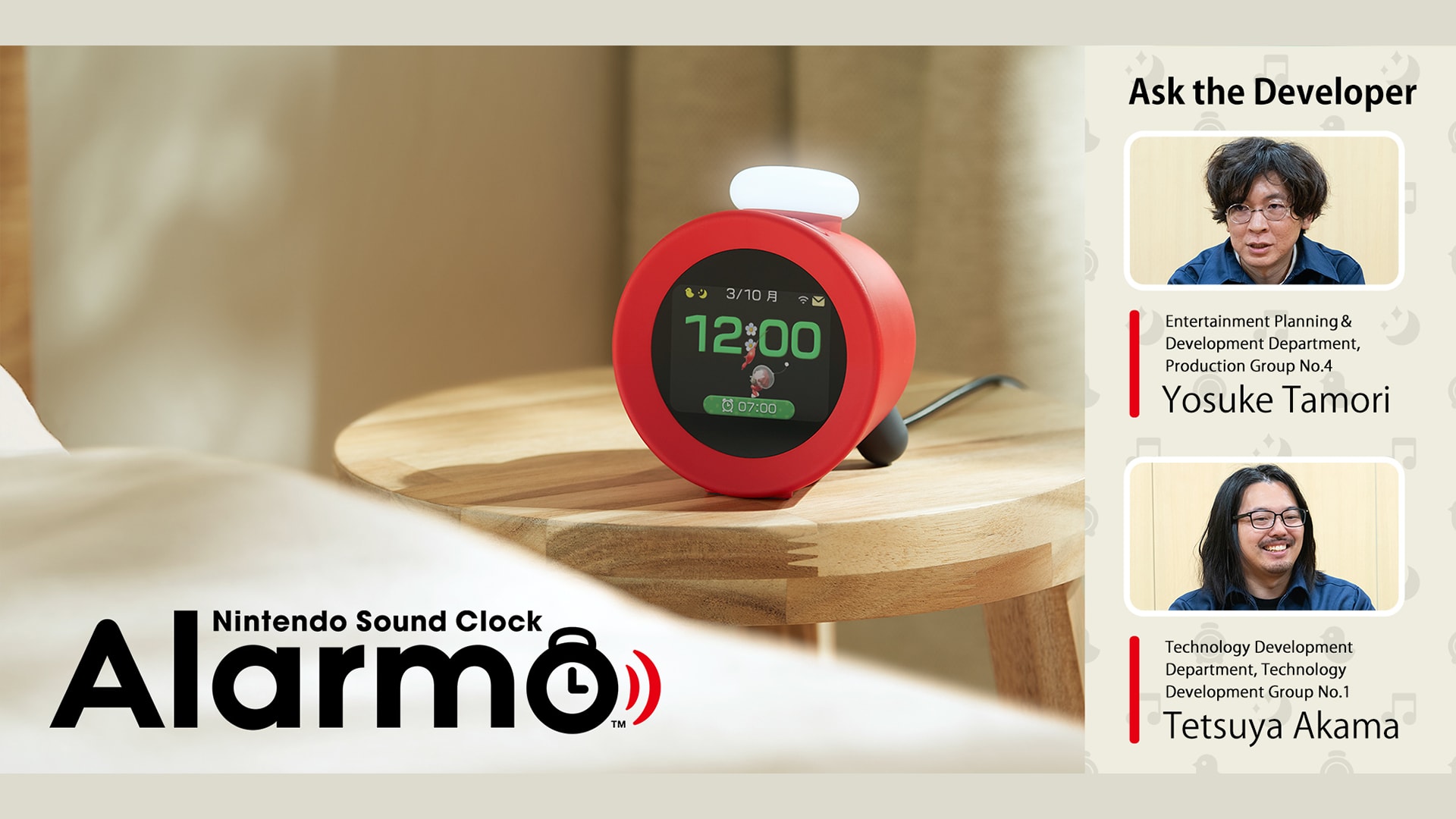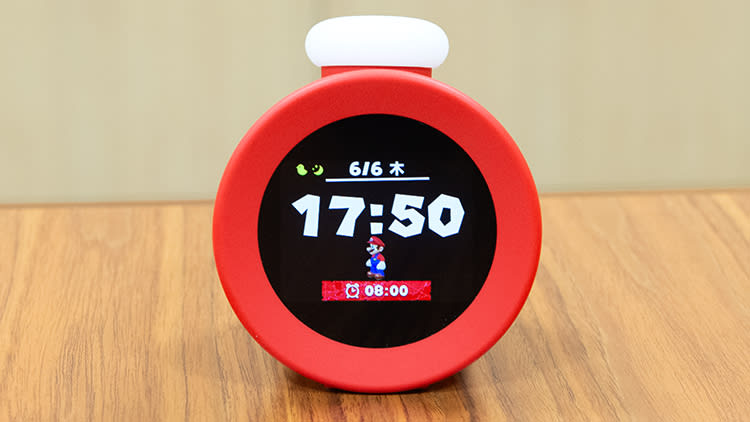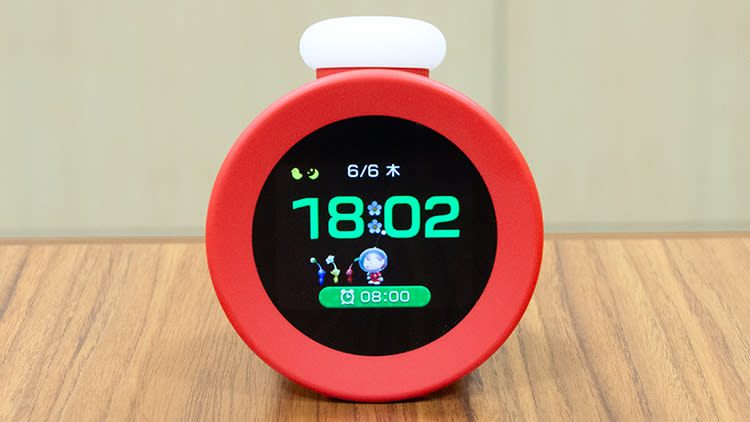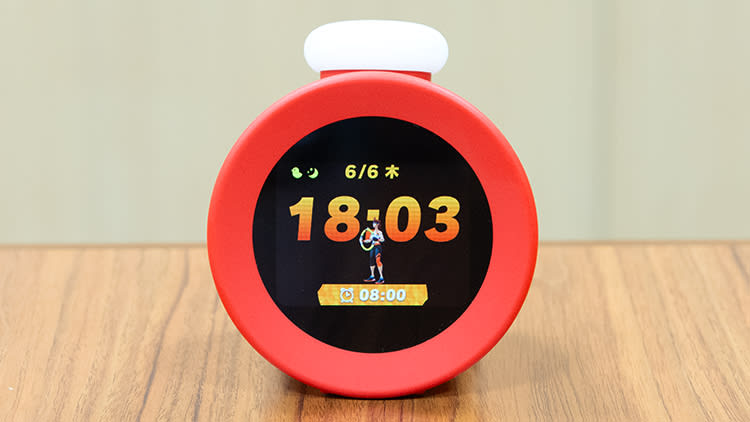
Ask the Developer Vol. 14, Nintendo Sound Clock: Alarmo — Part 4
This article has been translated from the original Japanese content.
Some of the images and videos shown in text were created during development.
All images show the Japanese version of the product. Nintendo Sound Clock: Alarmo is available in English.
In this fourteenth volume of Ask the Developer, an interview series in which Nintendo developers convey in their own words Nintendo’s thoughts about creating products and the specific points they are particular about, we’re talking to the developers behind Nintendo Sound Clock: Alarmo™, available from Wednesday, October 9th.
Check out the rest of the interview
Part 4: Establishing a new convention for waking up
When communicating the features of Alarmo, I think its design and technology make an impression, but the alarm sounds and background music shouldn't be overlooked. At launch, seven tracks from each title—Super Mario Odyssey, The Legend of Zelda: Breath of the Wild, Pikmin 4, Ring Fit Adventure, and Splatoon 3—are available as alarm sounds. How did the idea of using game music come about?
Akama: When the project started, we had a meeting where we discussed how we would like to wake up. One thing that triggered the idea of using game music was when the team got excited over the theme of “Waking up one morning to find I was..." While coming up with ideas like, “Waking up to find I was on a beach in Hawaii,” and “Waking up to find I was a baby,” the conversation started drifting toward the idea that it would be great if you could wake up somewhere different every morning, like you’re traveling.
The conversation settled on how nice it would be to wake up in a game world, and so we decided to use game music. As if you’re waking up on a beach or on a grassy plain, just by changing the alarm sound, the scenes that you wake up to change as if you’re traveling. I believe that this is the unique power of Nintendo’s music to express the game's world and atmosphere through sound.
Indeed, music from various game situations is used for the alarm sounds.
Akama: We thought it would be best to have as many tracks as possible because if you get used to the same alarm sound, it could get harder to wake up no matter how loud it is. With that in mind, we've made it so you can either set the game music that plays as an alarm yourself or randomize it. More variety in sound means more variety in your daily waking up experience. So I think this might make it easier for you to get out of bed, and you start looking forward to waking up.
Also, background music plays for a while after the alarm stops, and Alarmo responds to your movement with sound to create an atmosphere of being in a game. Many of us gradually start to wake up as they move around. I'd be happy if people experienced waking up invigorated, as if in a game world, by moving their bodies.
Come to think of it, some people prefer to wake up quietly, while others want to be woken up firmly. How did you take those differences into account?
Tamori: We’ve prepared three different modes to wake you up: Steady Mode, Gentle Mode, and Button Mode. In fact, during the initial development phase, there was only Steady Mode, but the way you wake up varies depending on the person. Personally, I can get out of bed quickly once my alarm goes off, but I didn’t know until after this project started that some people stay in bed and zone out for about 30 minutes before getting up.
Some of those people were of the opinion that Steady Mode was too strong, so we added Gentle Mode, which lowers the volume and stops after just a little movement. We recommend trying Steady Mode first, and if you find it too noisy, switching it to Gentle Mode. Also, by connecting Alarmo to the internet, you can add Moderate Mode, which is somewhere between Steady and Gentle, so you can choose whichever one you prefer.
The other mode – Button Mode – is like a normal alarm clock, right?
Tamori: Yes. The motion sensor is designed to be at its most responsive and function best when Alarmo is used by one person, but I’m sure there are many families who sleep together in the same room. Because of the nature of the sensor, even if one person gets out of bed, the sensor may detect that other family members are still in bed and continue to play the alarm. Of course, if everyone gets out of bed, it will stop. However, the situation varies depending on the household, so in order to accommodate a variety of circumstances, we added a mode that will stop the alarm when you press the dial button.
Akama: The development team is continuously testing the product to experience it firsthand and improve its accuracy. Including Tamori-san and myself, about half of the development team members are using it in an environment where other family members are present, but I don’t think we’ve heard many complaints that it’s not user-friendly.
Another feature that families who use Alarmo like is the hourly chime. The hourly chime can be a very useful feature to help establish your daily rhythm, as it serves as a cue to go to school or work, or a reminder of your everyday routine. Of course, you can disable it if you prefer. The sound of the hourly chime and the on-screen presentation change depending on which game you choose to set, so it can be enjoyed in multiple ways.
It seems like the team put quite a lot of effort into developing the sound, including the choice of music, how to wake people up, and the hourly chime.
Akama: We did. Actually, the alarms for Alarmo were not produced by sound experts but rather by team members who worked on a project researching motion sensors, and based on the various things they learned about waking up during that time. As such, when developing the alarm sound, they considered how to make the waking-up experience easier and more comfortable instead of just using game music and sound effects. After that, of course, we had sound experts review and make final adjustments.
Tamori: Besides that, we had an especially hard time optimizing the alarm volume. Usually, when we develop game software, we think about people who are already awake, but this time we needed to develop it with sleeping people in mind. Contrary to when we create games, we needed to actually sleep to confirm if the alarm volume was right. Even if the alarm volume seems too low when heard at midday, it may be just right when heard while waking up. But the only way to really be sure was to sleep and see how we felt when we woke up. So, it was quite a challenge, as even one adjustment to the volume took a day to confirm.

We talked about how the decision to use game music was made during the early stages of developing prototypes, but I imagine people would probably expect it to include some game elements too, as it’s a Nintendo product. Alarmo doesn't seem to have any game-like elements. That must’ve been a big decision.
Akama: There were times when we considered whether or not to have game-like elements, but we decided against it from quite an early stage of development.
Tamori: If we implemented game-like elements, it can be assumed that users would continue to play with it in bed. In that case, it might end up disturbing their sleep instead. We didn't want to create that kind of situation because we wanted users to wake up refreshed. So we decided early on to exclude such playable elements.
Akama: It's always been our hope that people will continue to use Alarmo for a long time. With that in mind, we were also concerned that game-like elements might not be compatible. For example, if we were to create a system in which you receive a reward every time you wake up, it may motivate you to wake up as long as you’re still receiving the reward. But if we create that system, once the rewards stop, you may lose your motivation to wake up.
What's worse, once you get used to that system, you might even start to think, “Well, if there’s no reward, then I don’t need to get up.” We concluded that it would be best to remove game-like elements to encourage users to continue using it for a long time. Also, there were comments from the development team like, “Let’s not give users more tasks to do.”
Tamori: We decided not to implement elements that could restrain the user’s actions or be overly pushy. If we'd wanted to, we could've even implemented a system where users get a gold medal for waking up earlier than the alarm time and a bronze medal for waking up later. But that would've also meant pushing the idea on users that “waking up early is good, therefore you should wake up early.” That may be right for some people, but when it comes to Alarmo, we wanted it to be something that gently supports you. Regardless of whether you wake up early or late, it has the feature to simply record and let you know the hours of sleep each night. We hope that Alarmo will stand in a place where people will casually use it for a long time.
You mentioned that it doesn’t have any game-like features, but Nintendo characters are moving around on the screen. Was the decision to use characters made after the decision to exclude game-like features?
Tamori: All along, we've wanted to make it obvious that Alarmo's motion sensor is reacting to the users' movements.
Originally, we were thinking of a system where a simple circle is floating in the display. If you move to the right, the circle will stretch out to the right, and if you move to the left, it will stretch out to the left. If you get out of bed, the circle will bounce off somewhere.
It wasn’t bad in terms of an interactive experience, but the vibe was completely different from the clock’s display.
Even if it’s not a gaming console, when it comes to hardware released by Nintendo, people will still expect character elements. The interactive experience using motion sensors seemed to be improving, and the screen was changed to an LCD that could display Nintendo characters. Taking all of that into consideration, we agreed that it might be best to steer in the direction of proactively using characters.
Since Nintendo characters that appear in game series – such as Super Mario and the Legend of Zelda – each have their own characteristics, we thought that being able to choose which characters to show on the screen by switching the alarm sound would add further value to Alarmo. So eventually, we decided to proceed in that direction.
Knowing that the characters are there near you as you wake up each morning sounds like it will enhance your feeling of waking up in a game world even more. To close this interview, can we hear from both of you on how you'd like customers to use Alarmo?
Akama: First and foremost, I hope this product will establish a new convention for waking up. You wake up, enjoy listening to the game world for a while, and just by getting out of bed, a fanfare will play automatically and the alarm will stop. I hope that being able to change how waking up that day feels by choosing a different alarm sound will become a global standard in the future.
Just as touch screens and automatic doors are commonplace for today's generation, I'd be excited to see a new generation that's grown up with Alarmo and thinks of an alarm clock as something that makes a sound when you roll over, and stops automatically when you get out of bed.
How about you, Tamori-san?
Tamori: When you first start using it, I’m sure many of you will choose alarm sounds based on your favorite game. But once you get used to it, I encourage you to set it to random and enjoy waking up with a fresh experience every day, because a lot of work has gone into perfecting all of the alarm sounds using music from Nintendo games.
You don’t have to touch it at all when using it daily, although from time to time you might feel like checking how long you slept, or if there are any updates. I want Alarmo to be a presence that gently supports you and accompanies you in your daily life, without you having to take care of it. As Akama-san mentioned, I hope this establishes a new convention in everyday life.
With this alarm clock that's out of the ordinary, filled with the developer’s dedication, I’m looking forward to going to bed and seeing what kind of experience awaits me when I wake up tomorrow morning. Thank you very much.





